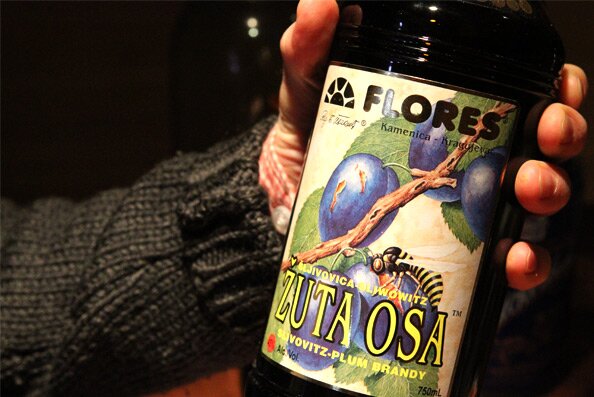
Monthly Archives: February 2011
Gourmet Underground Detroit's content archives are organized by date and catalog the aggregated content of our Features pages as well as our blog.
The Importance of Authenticity
Real mayonnaise isn’t something most people haven’t ever had these days. The paranoia over raw eggs and the effort required to make it oneself have put it off most people’s radar screens. So there’s a big market for the shelf stable, mass produced alternative. Taking it a step further is Miracle Whip, from which any hint of mayo has been removed then re-engineered and replaced with…something. Even Miracle Whip doesn’t brand itself as mayo; they call themselves “dressing,” which I think properly sets expectations for what one is about to buy.

The reason I’m thinking of Miracle Whip, which I haven’t had in ages and wouldn’t buy for any reason short of playing a practical joke on someone, is that I saw one of their new ads last night during the Oscars. It was a shockingly honest ad, and as hard as it is for me to contemplate, it showcases how Miracle Whip is a true, authentic product.
Miracle Whip is, of course, fake mayo. But their portrayal of the product is honest and authentic. It would be impossible to feel scammed by their promotion. One guy in their new ad says it tastes “like lotion, but sweet” and goes on to posit the question of why anyone would want that on a sandwich — this, in an ad for that very product. Obviously, the marketing guys are still marketing, still sending us a message. But they’re being forthright, building that message around people’s real perceptions and opinions instead of what some guy in a conference room thinks are people’s perceptions.
Interestingly, the Oscars themselves were full of moments of inauthenticity, which also illustrate the point I’m about to make. Melissa Leo took home the Academy Award for best supporting actress. Every newspaper on the planet predicted it. And disturbingly enough, Leo launched her own set of ads in Hollywood trade publications to campaign for the award. So how the hell is it that when she took the stage to accept, her speech was full of long, melodramatic pauses and brief outbursts of surprise as though she’d never contemplated this happening to her? She served up a heaping platter of disingenuous fakery, an accomplishment of high drama from an accomplished dramatic actress.

I, for one, will probably avoid every movie she ever makes from this day forward.
Why?
Because I’m part of that generation that’s grown up with 3,000 marketing messages thrust in our faces each day — on billboards, over the radio waves, on the television, on the internet, in my newspaper, and now, I’ve discovered, on the underside of some airplanes’ tray tables. I’m absolutely sick of some out-of-touch executive trying to push crap on me I don’t need, and I’m sick of certain celebrities pretending to be humble when they’re anything but, and I’m sick of piss poor food produced on an assembly line billing itself as some sort of natural, holistic answer to all my food prayers.
Lame, old school marketing doesn’t really impact my life, I suppose, so I simply may be a petty bastard, but it’s hard to deny that this constant barrage of messaging that lacks any credibility or authenticity is both irritating and omnipresent. Thus, it’s worth offering some commentary on the subject.
Last year, Todd wrote a pretty compelling rant about the absurdity of the marketing campaign conducted by Old Forester bourbon. Their branding folks had concocted a special Black Friday cocktail made from whiskey and 2 kinds of soda pop then encouraged people to rush home to drink it after shopping. The bourbon itself is fine, but in desperately manufacturing an angle to get people’s attention, they created something nonsensical. I have no doubt that they have found a niche for their product, but no one associates Old Forester with Black Friday, and I have to wonder if they wouldn’t be more effective simply being a bit more honest about their product.
People have been able to express themselves far and wide through YouTube, Facebook, Twitter, email, mass texting, and so on. We can find real people saying real things; and we can find real people saying fake things; and we can find fake people dressing up real cats in Barbie costumes and videotaping it.
The point, of course, is that transparent communication is all around us now. There’s a lot of static and bullshit as well, but that doesn’t mean the real thing isn’t out there and easy to find. And in a universe of people empowered to be their own restaurant critics on Yelp or their own movie critics on Rotten Tomatoes or their own wine critics on Eric Asimov’s blog, why do so many marketing executives still think the way to market to 21- to 40-year-olds is through pushing absurd messaging dripping with cow manure? Even 50- and 60-year-old consumers are moving to this style of communication and are adopting a lot of “younger” behaviors.
To some extent, I share a profession with these folks, and while I’m hardly innovating on a significant scale in the world of marketing, I’d like to think I have a bit more of a clue. Our jobs shouldn’t be to push something on people that they don’t want or need and to sell it with cheap tricks; our jobs are to connect what we offer to what consumers need. To do that, you need to understand their needs, their objections to your product, and who will actually buy it versus who is a lost cause.
That’s what Miracle Whip did so well, I think. I’m sure there are branding consultants and marketing gurus out there cringing, thinking to themselves, “You’ve surrendered your brand!” and “Why would you ever say anything negative about yourself?” But Miracle Whip realized that the conversation is already out there and that they cannot, no matter how much they want, control that conversation. All they can do is be a part of it and influence it.
So today, there are people going to their website to get a free sample of Miracle Whip (see the ad itself above). People like me who already hated it probably were never going to buy it and were always going to mock it, so why win us over? Instead, they’re going to just put their product out there “as is” and try to match it up with the people who really like it. They acknowledge the rest of us but they disarm us a bit by being honest enough to admit the truth about their product. Brilliant, I think.
Beyond Miracle Whip’s and Old Forester’s marketing campaigns, what does this have to do with food and drink?
Everything.
Authenticity is crucial not just in advertising and Oscar acceptance speeches. It’s how we form trust in someone or something: One must be credible to engender a relationship. Consider the Oscar show itself: It was widely reportedly the producers were going after “younger demographic,” so they injected iPhone references into the script and found two young, beautiful, charismatic hosts. But no one ever bothered to tell the writers that their crude attempts to mimic youth culture were destined to fail because they clearly never took the time to learn anything about it.
This morning, everyone’s talking about how the Oscars were a yawn, and I’d bet just about anything that rather than secure more viewers for next year, the producers simply created another group of cynics who will anticipate more failure from the Oscars next year.
Similarly, when wineries proclaim points, a lot of newer wine lovers and true aficionados have begun to balk at the whole concept, almost seeing the points as a sign of poor quality rather than good quality. Why? Because everyone knows that winemakers have manipulated their wines over the years to appeal to the palates of big name tasters in the media (Robert Parker, et al) rather than to their own palates. I want to trust the winemaker who knows the region and the grapes, not some overpaid critic with a singular notion of “good wine” who dumbs things down to a numerical scale. For a case in point, see the stunningly absurd James Suckling below:
The term typicité is often used to describe a wine’s particular uniqueness or charm, which itself generally relates to its terroir — the sense of “place.” Climate, soil, et cetera. In a tasting of older wines the other week, the wine that had everyone frowning was the wine had no sense of place. It was big and oily and loaded with a lotiony sweetness that I have no doubt the hater from the Miracle Whip ad would loathe (and perhaps conversely that all the Miracle Whip lovers would enjoy). I couldn’t have guessed that it was barolo if I’d sat there all night racking my brain. If I want wine that tastes like it was produced in a chemistry lab, why even bother labeling or growing grapes anywhere but California or Bordeaux? Engineers can make wine that tastes a certain way anywhere.
But it doesn’t ring true when you drink it. Like Melissa Leo’s speech, such a wine may immediately be gratifying because there’s an element of novelty and excitement to it, but over time, that fades and becomes burdensome — because these things lack honesty and integrity.
There’s no doubt that “authenticity” is a nebulous concept, that it can be abused, that there are entirely inauthentic ads that work, and so on. And saying that one needs authenticity doesn’t necessarily mean spontaneity — it’s quite possible to be clever and smart due to diligent thought and/or planning while still being genuine. But increasingly, I think that marketing professionals, winemakers, food producers, writers, Oscar producers, and just about everyone else are going to need to get used to the idea that the internet (among other things) has created a space in which authenticity (real or perceived) is valued over perfect taglines or focus group-tested flavors.
Strange that Miracle Whip inspired me to reflect on that, but it just shows that when you’re doing it right, you can reach just about anyone.
Three Little Pig Legs: A GUDetroit Tale
 Once upon a time, there were three friends who wanted to try their hands at curing prosciutto at home. As far as charcuterie went, one was a Novice whose experience was limited to the occasional fresh sausage or pâté; another, a Renegade who hung random cheeks and bellies in his basement with little care for recipes or precision. The third, who regularly cures and smokes her own bacon and had taken a class on prosciutto, offered to be their Fearless Leader. The Renegade procured three lovely pig legs from some Romanians at the village market, and the friends met one evening in his basement to roll up their sleeves and get to work (they may have enjoyed a glass of wine or two as well).
Once upon a time, there were three friends who wanted to try their hands at curing prosciutto at home. As far as charcuterie went, one was a Novice whose experience was limited to the occasional fresh sausage or pâté; another, a Renegade who hung random cheeks and bellies in his basement with little care for recipes or precision. The third, who regularly cures and smokes her own bacon and had taken a class on prosciutto, offered to be their Fearless Leader. The Renegade procured three lovely pig legs from some Romanians at the village market, and the friends met one evening in his basement to roll up their sleeves and get to work (they may have enjoyed a glass of wine or two as well).
The first part of the process involved removing the aitch bone from the legs, milking the large vein to remove the blood (to prevent spoilage), and trimming the legs  into a nice round shape. The Renegade and the Fearless Leader already had their legs pretty well trimmed by the time the Novice arrived, so she proffered her rolling pin to assist them with expelling the blood from the vein. When this was done, the FL showed her how to go about removing the aitch bone. She struggled and hacked, and didn’t make the neatest of cuts, but finally managed to free it from the leg socket. This, along with several pounds of trimmings, went into bags for another use. The skin was pulled back on all of the legs and trimmed to expose some of the flesh for salting.
into a nice round shape. The Renegade and the Fearless Leader already had their legs pretty well trimmed by the time the Novice arrived, so she proffered her rolling pin to assist them with expelling the blood from the vein. When this was done, the FL showed her how to go about removing the aitch bone. She struggled and hacked, and didn’t make the neatest of cuts, but finally managed to free it from the leg socket. This, along with several pounds of trimmings, went into bags for another use. The skin was pulled back on all of the legs and trimmed to expose some of the flesh for salting.
(Note on photos: Due to a computer malfunction, the author regrets to report the loss of the photos from the first stages of the process.)
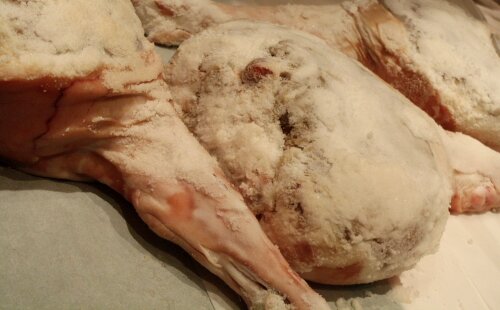 When the three pigs were trimmed (as neatly as these friends could manage with the tools at hand and relative lack of expertise), it was time to salt the meat. The skin was scored in a few places to allow the salt to enter. The Novice accidentally cut through to the flesh, but the FL reassured her that at worst, the meat may end up a little too salty in that spot. No matter, she thought, it can always be used in a soup or stew. The FL had brought a few pounds of Morton’s salt, a choice that surprised the Novice, but this was what had been used by the old Italian man who taught the FL’s class, and she posited that if it was good enough for him it was good enough for them. (We should note, it was the non-iodized variety.)
When the three pigs were trimmed (as neatly as these friends could manage with the tools at hand and relative lack of expertise), it was time to salt the meat. The skin was scored in a few places to allow the salt to enter. The Novice accidentally cut through to the flesh, but the FL reassured her that at worst, the meat may end up a little too salty in that spot. No matter, she thought, it can always be used in a soup or stew. The FL had brought a few pounds of Morton’s salt, a choice that surprised the Novice, but this was what had been used by the old Italian man who taught the FL’s class, and she posited that if it was good enough for him it was good enough for them. (We should note, it was the non-iodized variety.)
 The hams then rested for a week in the Renegade’s basement, turned every other day. After a week, the friends met for the next phase, pressing the meat. They improvised with a layer of towels, then parchment, in hopes of not getting the floor too dirty in the Renegade’s fancy booze and cigar room. A table was inverted and placed on the hams, and various items at hand were added to provide the proper weight- a case of wine, a case of beer, and an antique wine press.
The hams then rested for a week in the Renegade’s basement, turned every other day. After a week, the friends met for the next phase, pressing the meat. They improvised with a layer of towels, then parchment, in hopes of not getting the floor too dirty in the Renegade’s fancy booze and cigar room. A table was inverted and placed on the hams, and various items at hand were added to provide the proper weight- a case of wine, a case of beer, and an antique wine press.
After a week of pressing, it was time to rinse the hams and hang them to dry for three days, followed by a rubdown with oil (to keep the exterior from becoming too tough) and pepper (for flavor). The hams were showered off in the Renegade’s basement bathroom, and then hung from a clothes rack for three days to dry (fortunately the Renegade, a lawyer in a previous life, had several unneeded suits on the other side to counterbalance the weight). The Novice was out of town for the oiling and peppering, but she trusted that the others would lovingly season and rub down her leg as if it were their own.
 Now, the tale of the three pig legs comes to a pause, as the friends patiently wait for approximately 6 months for their hams to cure. In the following weeks, the friends will monitor the hams for any mold, wiping it off with white vinegar if it should make an appearance. The hoofs on their hams were somewhat of an unknown element, since the FL’s previous hams had been hoofless, but an abundance of salt was applied as a preventative measure. The second half of this tale remains to be written, but if all goes well, it will end with a salty, meaty celebration for all of their friends.
Now, the tale of the three pig legs comes to a pause, as the friends patiently wait for approximately 6 months for their hams to cure. In the following weeks, the friends will monitor the hams for any mold, wiping it off with white vinegar if it should make an appearance. The hoofs on their hams were somewhat of an unknown element, since the FL’s previous hams had been hoofless, but an abundance of salt was applied as a preventative measure. The second half of this tale remains to be written, but if all goes well, it will end with a salty, meaty celebration for all of their friends.
I’m an Evil Foodie
B.R. Myers, a windbag at The Atlantic, just published a fairly scathing critique of foodies and food culture in the United States. He’s not wrong that food has become a way for Americans to clearly differentiate themselves or that food writers seem to go to absurd lengths to create a staggering tale of food-centered adventure.
What he fails to point out is that sports writers, political writers, and entertainment writers are all in the same business as mainstream food writers — selling sensationalistic tales. And what he fails to realize is that people who enjoy food and would arguably be called foodies aren’t the monolithic entity he writes about.
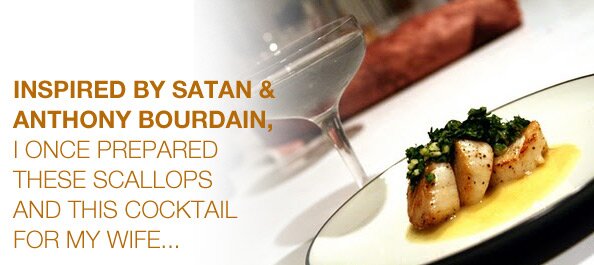
Despite his argument that American foodies are single-minded hoards of gluttons — in particular, he writes, “Needless to say, no one shows much interest in literature or the arts…” — a lot of “foodies” I know are as interested in sustainability, economics, history, and art as they are what they’re chewing or sipping at that moment. In other words, there can be — and ought to be — an intellectual component to a hobby, and that’s as true of food as it is anything else.
People I’ve had the pleasure of meeting through this whole Gourmet Underground Detroit endeavor are all interested in food — but some are interested in turning it into a business, others are interested in historical and cultural aspects, others are interested in how food is turned into art, others use it as an entry point into learning more about a language, and so on. And all of them have other hobbies and interests, be it poetry or film, photography or computer geekery.
Dave Kwiatkowski from The Sugar House is a food-loving cocktail obsessive who owns a motorcycle shop. GUD co-founder Todd Abrams loves American poetry, sculpting with clay, and Hemingway. And they can’t get together without talking about Stanley Kubrick. James Cadariu of Great Lakes Coffee just wrote a great feature piece for GUD about the intersection of drinks and community in other cultures, standing in stark contrast to Myers’ portrayal.
So with nary an endangered animal on their plates and with interests outside of food, where do they fit into Myers’ sinister picture?
I hate the word, but I suppose you’d have to call me a foodie. B.R. Myers thinks that makes me an evil glutton. Maybe that’s true; maybe it isn’t. But what’s certainly true is that Myers is reacting exclusively to a typically over-the-top American mainstream media portrayal of food and foodies, and as an essayist or journalist or editor, he ought to know better than to look to that group for what’s really happening in this country.
At the very least, he should come to Detroit and have an earnest discussion with some other evil gluttons — perhaps over a cup of Great Lakes Coffee’s latest micro-roast and a cherry-almond agar-agar dessert from Neighborhood Noodle.
You’d Think We Were Drunks
Blogging for Gourmet Underground Detroit has been fairly drink-heavy of late, with Todd, Dave, and I posting mostly cocktail recipes and suggestions for waiting out blizzards using only wit and whiskey. Not a whiff of food-related comments or links to be found anywhere.
Tonight, that changes. But only because I want to mention a wine or two.
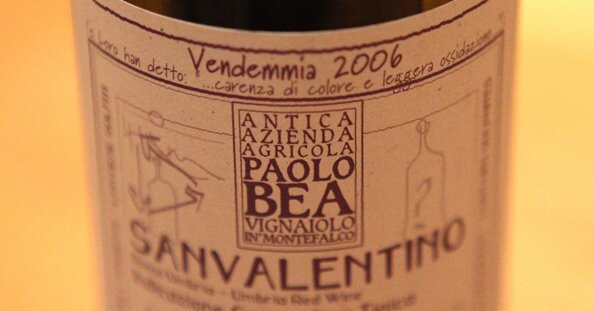
Worry not, food lovers. A feature on grass-fed meats is on its way. But in the meantime, snuggle up to your lover with an adult beverage. Perhaps one of those that follow.
Unnamed Tea Cocktail
I discovered a bottle of black tea gin in the back of my cabinet, an infusion that I’d made last year in order to make Dave’s Laura Palmer. Inspired by that drink, I tweaked the proportions seeking to emphasize the bitterness in the tea. In essence, I just swapped out limoncello for Aperol:
1.5 oz black tea infused gin
.75 oz Aperol
.75 oz lemon juice
.25 oz 2:1 simple syrup
I shook this with ice, strained it, and served it up. The lemon and the tea are dominant, but the Aperol adds a nice bitter edge to the end. Matches up nicely with the herbal/tannic quality from the tea, but it’s still refreshing.
Some Weekend Wines
Fellow GUDer Todd Abrams came over on Friday night, and over deeply intellectual discussion (read: drunken and aimless arguing) regarding American poets, he, my wife Susannah, and I drank well — a few cocktails and a couple of great bottles of wine.
Todd brought some Domaine de Roally Viré-Clessé Tradition, which manages to never, ever disappoint. Despite its heritage as a white burgundy (albeit from a lesser known appellation), I always think this has a really pleasant mineral quality to it, no doubt a result of the vines being grown in a limestone-rich area. Roally always explodes on the palate — lemon, toast, fleshy fruits, stone. It’s subtle in its complexity, but there’s nothing subtle about how it lingers and continues to dole out flavor. I’m always happier for having opened a bottle of this.
We also got into a bottle of Paolo Bea’s 2006 San Valentino, brought to us by reliable wine importer Neal Rosenthal. Located in the central Italian region of Umbria, Bea makes some of the best wine I’ve ever had. This bottle in particular is something of a treat since it normally would retail for double what I paid. This particular bottle was rejected by the Italian wine police, who didn’t allow Bea the DOC label because the wine wasn’t deeply enough colored and because it was showing a bit of oxidative brown. He released it as an IGT, and I’ve now plowed through three bottles. This, like the previous two, was excellent. Unlike its “big brother” flagship wine from Bea, this bottling is very soft throughout the whole glass without quite as much tannic power as Bea’s bigger wines. Still, it’s remarkably complex — cherries and red currants, very floral nose, and layers of herbs and spice, something it very much shares in common with the other Bea wines I’ve had. The predominant grape in this wine is Sangiovese, but italso has Sagrantino and Montepulciano. This producer makes wines that can hold themselves up and age for a bit, impossibly layered, but that are also every bit as fun to drink as a ripe, acidic natural wine.
And have fun drinking it, we did.
The Hospitality of Spirits: A Journey to Eastern Europe and the Celebration of Booze, Family, and Life
Serbian Spirits
My true love of Eastern European hospitality sprang up in Belgrade, Serbia in 2007. My last aunt born in Serbia had died and left my dad a small sum of money. Being a generous and sentimental fellow, Dad planned an expedition to Serbia and Romania for the family. I’d been to Romania before but never Serbia due to the incessant conflicts during the 90s. Mom, Dad, brother and I set out for the ancestral villages on both sides of the border.
We flew into Belgrade and our cousin Ovidiu, or Ovi, met us at the airport. Dressed in all black with black hair and a stocky frame, Ovi looked much like an Eastern European gangster, or at the very least, our protection from Eastern European gangsters. It’s fortunate that my dad had met him before.
Being Romanian American in Serbia would have been a challenge, as we don’t speak Serbian. Serbian died out with my grandmother who was born there but ethnically Romanian. Ovi was the language link to our own past.
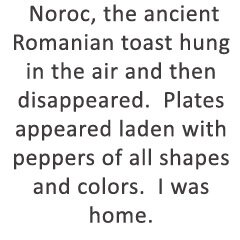 We checked into a hotel for the night and headed to the Shadorska, the Bohemian district of Belgrade, for dinner. You could tell Ovi didn’t make it into the city often. He was as excited as we were. As we walked down the curving cobblestone street, two women called out from the restaurant Dva Jelena. They were framed in the restaurant entrance by a mass of cascading flowers. This was the place we were meant to be.
We checked into a hotel for the night and headed to the Shadorska, the Bohemian district of Belgrade, for dinner. You could tell Ovi didn’t make it into the city often. He was as excited as we were. As we walked down the curving cobblestone street, two women called out from the restaurant Dva Jelena. They were framed in the restaurant entrance by a mass of cascading flowers. This was the place we were meant to be.
The interior was all inlaid woods and mystery. Drinks were needed. I wanted to try some slivovitz. It was only normal and the list of brandies was no smaller than an entire page. I looked to Ovi to translate. As his eyes scanned down the page through the selection of slivos, he paused. He turned towards me and in a reverent tone said, “zuta osa.”
I had no frame of reference for what those two words meant, nor what they would later mean. I did not expect them to signal a shift in how I viewed the world. Ovi explained that zuta osa was special slivo. It meant yellow wasp but had another meaning. Yellow wasps were an indicator to the plum farmer that the plums were ripe for picking. The secondary meaning was due to the color of the plum brandy once it had been distilled and aged in oak barrels. The color was as yellow as the wasps. We ordered a round.
Ovi had a simpler rakija. He wanted us to have the best out of respect. A tray of shot glasses was brought out with no fanfare. Amber in color and fragrant as an orchard in autumn, the zuta osa beckoned. As I lifted the glass to my mouth, I felt connected with another world, with my family, with my forebears, with this new, old land.
My mouth burned with alcohol as I took a sip. Then the fruit exploded on the finish as the heat migrated into my stomach. Noroc, the ancient Romanian toast hung in the air then disappeared. Plates appeared laden with peppers of all shapes and colors. I was home.
It was a feast. Musicians entered the scene. As they struck the first chords, the man at the adjacent table began to sing. The songs were melancholic, nostalgic, the same feelings I was beginning to understand about a place I’d never known but now occupied.
Family Spirits
We arrived at the farm in Sutjeska the following day. The land was flat and wide, full of sunflowers, corn and fisheries along the Danube. The houses of the village were huddled together as if for protection. We pulled in the drive and stopped at a rusty, metal gate behind which was a courtyard full of strutting chickens. Could they be dinner?
Silos of dried corn framed out the courtyard. I could see around me all the simple signs of sustainable living we have become so enamored with in the West. We entered the main house, put on slippers and entered the living room. A family waited.
As I was introduced to these wonderful people, a tray of slivo was produced, this time homemade. Noroc! While the men toasted each other the women brought out plate after plate of food like bees returning with pollen to the hive: pork schnitzel, roasted potatoes, red pepper salad, fresh bread, on it went.
Bottles of homemade wine accompanied the feast. I realized I might never have a meal again as fresh as this. I was home. As the celebration continued, more and more relatives arrived. Meal one was followed by meal two after an interlude of intense conversation: more schnitzel, roasted chicken (aha) and a plate of house cured pork beyond imagining. We slept a country sleep.
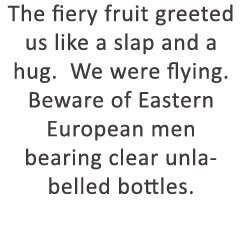 The next morning more relatives came. One guy, when offered coffee, then beer, said yes to both. After that, we went to the big town of Ecka where my paternal grandmother was born. We cautiously drove down a road of uneven, hand laid bricks. A short man in all black and a fedora haled us from his bicycle. He invited us into his house.
The next morning more relatives came. One guy, when offered coffee, then beer, said yes to both. After that, we went to the big town of Ecka where my paternal grandmother was born. We cautiously drove down a road of uneven, hand laid bricks. A short man in all black and a fedora haled us from his bicycle. He invited us into his house.
We sat at a simple kitchen table and were offered quince brandy and a plate of cured pork. Noroc! They had been waiting. As we discussed the brandy, the man agreed to take us down the street to see the local brandy distiller.
The distiller was a Serb who greeted us at his gate. He explained the process and showed us the copper alembic still assembled in his garage. The Serb mainly made plum and apricot brandies and proceeded to produce two clear bottles. He commanded us to drink in Serbian. Though we couldn’t understand the precise words, we knew exactly what he meant.
We took deep swigs and passed the bottles around. The fiery fruit greeted us like a slap and a hug. We were flying. Beware of Eastern European men bearing clear unlabelled bottles.
Simple Spirits
As the crow flies, my grandfather’s village Guilvaz is only 40km from my grandmother’s village in Serbia. What God had joined together in geography man can somehow sever. Banat, the region, straddles the border of Romania and Serbia. Through communism, wars and Romania’s ascension to the European Union, now it takes about 3.5 hours to drive between villages, past closed borders, and through nonsensical zigzagging turns in the road.
Ovi drove us to the border after a random stop at an official’s house for what I assumed was a furtive payment to let us cross the border. Our Romanian driver, also named Ovi, met us on the Serbian side. Hello Ovi, goodbye Ovi.
Guilvaz is much poorer than Ecka and Sutjeska. An E.U. sign met us on the outskirts of town. A new lamb abattoir had been built. Our cousin in the village later told us the owners wouldn’t hire local Romanians because they feared the locals would steal the meat.
As we drew close to the village a train rumbled by with its doors flapping open and closed. Another man in a fedora on a bicycle caught up to us and showed us the way to our destination. Where do these guys come from?
The road had never been paved. It was rutted as if a meteor shower had rained down and grass had grown over the enduring indentations. We passed a ruined church, abandoned buildings, a horse grazing in front of a house, and an old woman planting seeds.
After reaching my cousin’s house the road gave out to farmland. Nearby, a healthy, white pit bull sat in the driver’s seat of an old Dacia car. We ducked to enter the doorframe of the house. Not just the big news in the village, we were the tallest people by a foot.
We walked through a small room with a tile furnace and a low wood ceiling before entering a dining room where a colorful table had been set. After being poked and prodded by the newfound relatives, a clear bottle of tuica (Romanian for plum brandy) was produced and glasses raised.
This time the brandy was all fire and brimstone, hellfire and damnation to follow — rustic, you might say. The food was simple and fresh: house-cured pork, sausages, tomatoes, cheese, peppers, roasted chicken and potatoes. More relatives arrived from Timisoara, the big city. More glasses were raised and drained.
We went to see my grandfather’s house and were met by a couple of squatters who were ill prepared for my dad’s arrival and story. They were from an even poorer region called Oltenia and insisted that they had paid money for the house. It was rather unlikely since my grandfather had bought the house when he went back in the 50s. Moreover, they were the second couple I’d met in the same house with the same story. My dad could have reclaimed it post communism but he wasn’t going to kick these people out. For what good?
Sophisticated Spirits
From village relatives to the city relatives, we drove from Giulvaz to Deva, a mid-sized Romanian city in the mountains best known as the headquarters for Romania’s powerhouse gymnastics program. Dan, Rodica and their daughter Tana have stayed with us in the U.S. and we know them in a less awkward way than the man-on-a-bike-style relatives from the villages.
Dan is an architect and had redone their Communist-era condominium apartment since last I had darkened the doorstep in 1993. Walking up the uneven steps in the dark stairwell I smelled the signs of communist construction. I wasn’t prepared for the marvel of design that lay behind door #26.
 Dan had gutted the small kitchen, living room and one bedroom to install a completely open floor plan. One side featured a plaster wall with asymmetrical cubbies housing Romanian art. The other side was a curving kitchen bar and a backsplash made of limestone from a local quarry.
Dan had gutted the small kitchen, living room and one bedroom to install a completely open floor plan. One side featured a plaster wall with asymmetrical cubbies housing Romanian art. The other side was a curving kitchen bar and a backsplash made of limestone from a local quarry.
Next stop was the liquor cabinet. There was Tuica and a toast from Dan. It seems that the German toast “prost” actually means dumbass in Romanian and Dan made full use of this fact. But then, Dan is also a part-time comedian and a chain-smoking ringer for Vladimir Lenin.
We ate beet soup with sour cream, spit-grilled lamb and a macedoine of vegetables. Then Rodica brought out a papricas of mushrooms served over a bed of mamaliga, the Romanian national dish or cornmeal mush or polenta if you prefer. A bottle of Feteasca Neagra complimented the spicy paprika dish.
After the meal, Dan wanted to show off his new Audi and some of the buildings he’d designed around Deva. We blew through the empty streets with the ominous Deva sign shining on top of the citadel, Hollywood-style. He showed us a hotel, church and a bank, all very modern in contrast to the crumbling apartment blocks and remnants of traditional structures. The only sounds heard above the hum of the A6 engine were the barking of stray dogs.
High Octane Spirits
The next day a long drive took us out of the mountains and back towards the Danube River and its delta. The hills were terraced with vines. Turkish and Tatar villages occupied the land amid the reeds and wetlands. We ferried the Danube at Galati. The land was losing sway to water and thatch appeared as a roofing material.
We drove a single-track road until it ended in the middle of a field. We were lost. Someone produced a phone number for the boat launch and we made our way back to a beach-like pond area filled with boats, rusty buildings and lazy dogs. We clambered aboard an open-air skiff. The luggage was casually tossed in the back of the boat causing the boat to sink within an inch of the river level. Meanwhile, darkness prevailed.
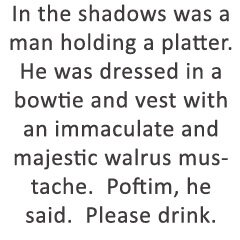 The boatman pushed off from the shore, opened up the motor and we were hauling ass in the dark through a narrow channel as trees whizzed by. The luggage shifted and I had to wrap my arms around it before it slid into the Danube. We started letting out whoops of excitement as we banked from the narrow channel to the wide-open Danube. You could feel the immensity of it even if you couldn’t see it. The sound shifted, the wind shifted, the boatman was guiding us through pure experience.
The boatman pushed off from the shore, opened up the motor and we were hauling ass in the dark through a narrow channel as trees whizzed by. The luggage shifted and I had to wrap my arms around it before it slid into the Danube. We started letting out whoops of excitement as we banked from the narrow channel to the wide-open Danube. You could feel the immensity of it even if you couldn’t see it. The sound shifted, the wind shifted, the boatman was guiding us through pure experience.
Nothing was visible either in front of us or on the shore for that matter, wherever it might have been. We were fully at warp speed. At a certain point our eyes adjusted to the darkness and we could make out the faint outline of trees lining the riverside. The only light we saw before the hotel was a fire someone had lit.
As we approached the hotel, the light grew but it still felt lonely. The light was dim. The darkness was great. There was no doubt that nature was in charge out here. The boatman guided us expertly alongside the dock and, like a gymnast dismounting from a pommel horse, jumped out of the boat and tossed our luggage on the quay in one fell swoop.
In the shadows was a man holding a platter. He was dressed in a bowtie and vest with an immaculate and majestic walrus mustache. Poftim, he said. Please drink. On the platter were shot glasses filled with palinca, the even more fiery sister to tuica. We all did rapid-fire shots, including my mom, a lifelong teetotaler, and the boatman.
Artistic Spirits
Believe it or not, a trip lasting from the hinterlands of Serbia to the Black Sea coast would end up in Bucharest at the exact same time as a NATO meeting featuring then-President Bush. The streets were clean (unusual for Bucharest), quarantined and quiet. It took some logistics just to reach our hotel. What was even more surprising was a blanket ban on alcohol sales along the diplomatic route. The only time I’d encountered such a prohibition was in India during election voting and after a tour of the Labrot Graham distillery in Kentucky. But we were in Bucharest, not Bourbon County.
We checked into our hotel near Piata Victoriei and walked around the corner to Ioan Nemtoi’s studio. Ioan is a friend of my dads and an expert glassblower whose glass art we import into the U.S. His studio has an ‘Alice in Wonderland’ aspect to it with crashing colors and myriad shapes arranged on pedestals fabricated from metal and wood.
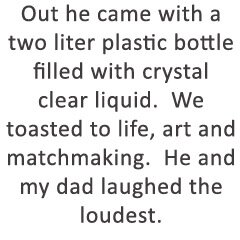 Ioan was late so I waited out on the street. A leggy woman approached with a head of blonde hair so thick I couldn’t see her face. She greeted me with “buna” and slipped by into the gallery. The woman was Ioan’s stepdaughter who I was being fixed up with later.
Ioan was late so I waited out on the street. A leggy woman approached with a head of blonde hair so thick I couldn’t see her face. She greeted me with “buna” and slipped by into the gallery. The woman was Ioan’s stepdaughter who I was being fixed up with later.
Ioan arrived shortly, squat and bearded like an Orthodox priest. Typically only priests wear beards in Romania, so with Ioan, my dad and I similarly bearded, it was like an Ecumenical Council of the Patriarchs. It ended up being a species of communion. Ioan’s eyes danced as we recounted our exploits and inability to get a drink in Bucharest. Not to worry, he exclaimed, and disappeared into a room at the back of the gallery. Out he came with a two liter plastic bottle filled with crystal clear liquid. We toasted to life, art and matchmaking. He and my dad laughed the loudest.
Home Spirits
My dad and I import art from Romania and hope to expand into wine in the near future. The main thing I have imported thus far is the disposition of the hospitality of spirits.
With this outlook, I had a basement party last year filled with house-cured pork, plum brandy (zuta osa is available locally) and Romanian music. This is the ethos of the Gourmet Underground Detroit: curing pork, making sausage, fermenting vegetables and beverages, canning, toasting, and celebrating. All these iterations were in evidence at the Holiday Food Bazaar last December organized by Noelle Lothamer. It was as much social as commercial.
At some point all of our ancestors brought their traditions to this area. Sadly much of our handed-down knowledge has been severed by corporate food business and the desire to make money above all else. But there is something inside us which longs to be in touch with nature and other people. This spirit cannot be bought or sold. It can only be celebrated. Noroc.
Crimson Dynamo
This post originally appeared on The Sugar House blog of cocktails and progressive nipple waxing.
If you’ve read my blog, you know I’m a big fan of Laphroaig. It’s my go to liquor. My hearty sauce. My good place party time. And my friends have accused me of adding it to just about any drink and remarking on the drink’s improved taste. But this time it’s different. This time it’s special. I made this one at 4 am a few weeks back and have been received very positive, if somewhat biased, feedback on it.

Crimson Dynamo
1.5 oz. Laphroig
1 oz. Campari
.5 oz. Luxardo
Stir & strain, garnish with an orange peel twist.
Sweet, smokey, bitter… everything I want out of life.
The Treacle
This post originally appeared on The Sugar House blog of cocktails and at-home wizardry.
I picked this one up from Gary Regan’s twitter feed (@gazregan). It was invented by Dick Bradsell, patriarch of the UK cocktail scene. You can see the whole article here. It’s a surprisingly simple combination of only a few ingredients, but as the saying goes, if it’s good enough for Gaz, it’s good enough for me. 
The Treacle
2 oz. Dark Rum
.5 oz. Simple Syrup
Dash Ango
.5 oz. Fresh Pressed Apple Juice
Prepare this as an old fashioned: build in the glass over ice, stir. Float the apple juice on top, drink, win.
Gaz recommends Myers, but I only had Goslings Black, which did the job just fine. I also used Honey Crisp apples, which are by all accounts “extremely tits.” And, if you wanted to garnish it with a crisp little apple slice, I wouldn’t blame you… you’re clearly a genius.
How to Prepare for a Blizzard
Blizzards are devastating natural disasters that can cause a great deal of damage in a short time. More importantly, they are an ideal excuse to take a guilt-free day off of work. Because blizzards are somewhat predictable, it’s possible to call-in the evening before, thus allowing you to get stupid drunk without even the pretense of setting your alarm. Follow these steps to prepare for Detroit Snowmageddon 2011:
1) Take weather alerts and warnings seriously and make damn well certain you are not going to run out of booze.
2) Create a disaster plan. For instance, if you do run out of booze, are your neighbors bitchin’ and willing to share theirs? If not, you should move to a cooler neighborhood.
3) Have an emergency blizzard kit ready at all times. A typical kit might contain one to seven bottles of good whiskey, habanero cheese, a variety of pornographic materials, tortilla chips and spicy hummus, a toothbrush, and Cajun peanuts.
4) Gather tools like shovels, ice picks, cherries and sweet vermouth. Leave them near your whiskey so you can replenish your Manhattan cocktail without too much fuss.
 5) Plan for an alternate source of heat if you rely on electricity for heating. (see item 3)
5) Plan for an alternate source of heat if you rely on electricity for heating. (see item 3)
6) Charge all electrical devices before a blizzard. Power outages could last for days and it’s very difficult to alert your facebook friends how much snow there is in your driveway if your laptop is dead.
Good luck out there.



